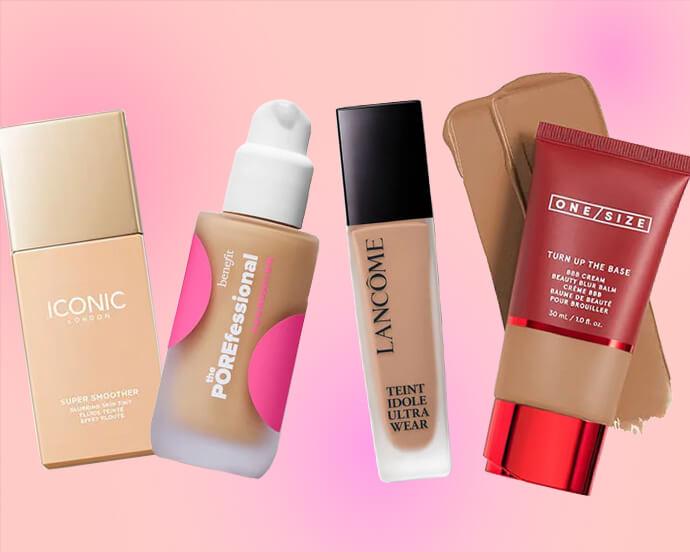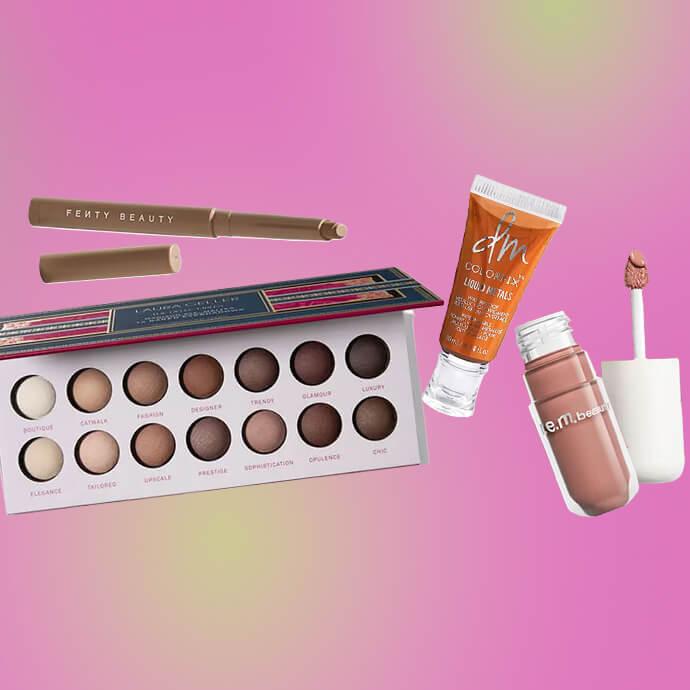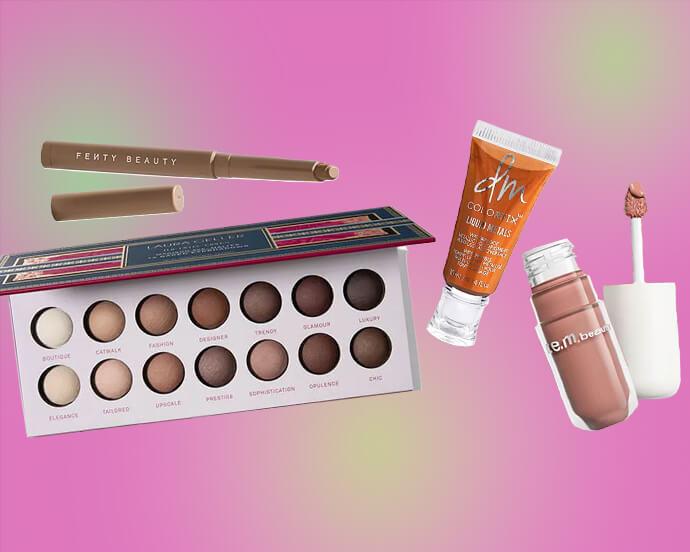When Does Makeup Expire, and Can We Actually Extend Its Shelf Life?



Dahvi Shira


Photo by ETIENNE LAURENT AFP/Getty Images
Looks can be deceiving. While yes, there are often immediate signs of bacteria in our beauty products (ie. a fuzzy veil over our eyeshadow, or separated liquid foundation), not all indicators of expired beauty products are the same. We’ve often lived by the mantra, if it ain’t broke, don’t fix it. So that decade-old lipstick passed down by our mom? We’ve used it. That one spendy eyeshadow palette from college? Can’t part with it. After all, if it’s still working, what’s the issue? Well, there can be a lot more going on than meets the eye.
“When makeup products expire, they harbor germs and bacteria,” says professional makeup artist Ruby Vo. “So when you apply [an expired] product to your face, it can cause skin irritation, breakouts, or even infection.”
In fact, celeb makeup artist Manuel Espinoza says the actual makeup composition can change over time, so you may not even be using what you started with. “As much as you may be emotionally attached to a makeup product, it’s important to protect your skin and throw it away,” he shares. “Some makeup brands have come out with cute, limited-edition packaging and that’s perfect to keep as a souvenir. However, it’s important to avoid applying these expired products to your face! Instead, put them on display on your vanity or in your bathroom.”
That’s right, all good things must come to an end, makeup products included. According to cosmetic chemist Joseph Cincotta, PhD, “No makeup products are meant to last forever, and typically only last 2-3 years sealed.”
So how do you tell when your makeup is approaching its end-date? There are a few tell-tale signs to watch for. The best way to tell, of course, is by checking the expiration as soon as you buy it (more on that below).
Want to make sure your favorite makeup products are safe to use? Continue reading below to learn about makeup expiration dates for some of your most commonly used products, plus how you can keep them clean and safe, so they’re good to their very last day.


It's about glam time you treated yourself.
MEET THE EXPERT
Joseph Cincotta, PhD is a cosmetic chemist.
Ruby Vo is a Los Angeles-based professional makeup artist
Manuel Espinoza is a celebrity makeup artist and Black Radiance ambassador.
How Do You Tell When Makeup Is Expired?
We’ve definitely been guilty of opening brand new makeup products without giving their expiration dates a glance. And if you’ve ever pulled out a concealer and thought, “How long have I been using this?” We’ve been there, too. But, it’s actually very easy to determine how much time you’ll have with your new makeup.
“On the back of every product there is a small illustration of a container with an open lid that has a number such as 12M or 24M on it,” says Cincotta. “In the lab, stability and compatibility testing at various temperatures is done to determine the shelf life of a product. That is the recommended amount of months after opening that product that it should be discarded.”
That’s right—the clock starts ticking when you first open it, not when you buy it. This can make it trickier to determine how long you’ve been using your makeup, because it’s not as simple as checking a receipt date. “I recommend getting a label maker and putting the date of the day you opened the product at the bottom so that you can keep track of the expiration date,” says Vo.
But that doesn’t mean makeup that’s unopened should sit around forever. Unopened makeup products have general shelf-lives as well. Natural degradation can cause ingredients to break down over time and they can sometimes become unsafe to use. “Never keep an unopened product for more than 3 years since preservatives typically become ineffective [after],” says Cincotta. “Creamier products (cream concealer or cream blushes) that contain oils can go rancid in 1-2 years.” It’s also very important to know the shelf life of products made without preservatives (such as natural ingredient-based products) as they are more likely to grow bacteria without that line of defense.
And it probably goes without saying, but “look out for the product’s smell,” advises Espinoza, who notes that whether it’s a liquid, cream, or jelly product, if it smells different than it once did, immediately time to toss. “Powder products tend to last longer, but will still expire and eventually lose their effectiveness.”
What Are Common Makeup Expiration Dates?
While checking your product’s expiration symbol—also known as the POA (Period After Opening) symbol—is a surefire way to know its shelf-life, there are some general guidelines you can follow to help. Our experts help us break down these common makeup expiration dates below.
Liquid Foundation and Concealer Expiration Dates
Shelf Life: 3 years unopened, 6 months from first use
Tip: Pour foundation onto the back of your hand before applying instead of dabbing your beauty sponge, brush, or fingers on the neck of the bottle. This will help keep bacteria from entering.
Mascara Expiration Dates
Shelf Life: 1 year unopened, 3 months from first use
Tip: “For items like mascara or liquid eyeliner or any item that has a brush, wipe the brush with alcohol after every 2-3 uses,” says Cincotta. Also, never share your mascara with others to lower the risk of eye infections.
Espinoza adds: "For products that may dry out like mascara, lipstick, or lip liner, as much as you may be tempted to add water to keep the product’s moisture, I would highly advise against this. I spent 12 years working with MAC COSMETICS, and during my time in product development, I’ve come to learn that introducing any type of moisture can lead to bacterial growth and change the formula and texture of the product. It’s important not to add anything to the product that would alter the original formula. Instead, to extend the shelf life of these products, I recommend storing them in a cool, dry place."
Pencil Eyeliner Expiration Dates
Shelf Life: 1 year unopened, 3 months from first use
Tip: Sharpen your eyeliner after each use (even just a little) so you’re using a fresh tip each time, and keep it away from humid places where bacteria can grow more easily. Like mascara, never share your eyeliner, as bacteria can cause eye infections.
Liquid or Gel Eyeliner Expiration Dates
Shelf Life: 3 to 4 months from first use
Tip: Gel or liquid liners are loaded with moisture that can trap bacteria and encourage it to grow. Never share these products and store them in a cool, dry place.
Lipstick Expiration Dates
Shelf Life: 3 years unopened, 3-6 months from first use
Tip: Lipsticks harbor bacteria pretty easily as they’re always exposed to moisture from your mouth. Storing your lipsticks in a cool dry place will not only prevent makeup meltdown, it’ll also help discourage bacteria growth. We also suggest applying with a clean lipstick brush. It can seem like a bit of extra effort instead of applying lipstick directly to the lips, but the lipstick is exposed to less moisture and less bacteria.
Powder Blush and Bronzer Expiration Dates
Shelf Life: Two years, opened
Tip: Regularly clean your blush and powder brushes to keep germs, skin cells, and oils from transferring onto your products.
Nail Polish Expiration Dates
Shelf Life: 3 years opened or unopened
Tip: Keep your polishes out of direct sunlight to keep them from separating and prevent discoloration. Cincotta says to “shake your nail polish well if separation occurs.”
Makeup Sponges Expiration Dates
Shelf Life: 3-6 months from first use
Tip: “Sponges hold so much bacteria and depending on how you store them, they can collect a lot of dust,” says Vo. “People should be washing their makeup brushes every 7-14 days. I also recommend washing your makeup sponge before every use and replacing it every 3-6 months.”
Can You Prolong a Product’s Shelf Life?
Following the tips above will help keep your makeup stash fresh, but you should still follow the product’s makeup expiration date to be sure it’s 100% safe to use. That said, a few good habits will make sure your products live up to their shelf life and don’t separate, become discolored, ineffective, or contaminated before they’re due to expire.
Don’t Share Makeup
We know, it’s hard. But while sharing some products (like nail polish) is OK, there are certain ones you should keep to yourself. Eyeliners and mascaras can easily become contaminated—you should regularly clean your eyeliner tips and mascara wands to prevent this—and with the eye area being particularly sensitive to bacteria, it’s best to keep them to yourself.
Wash Your Hands
“Always wash hands before touching or applying makeup with your fingers,” says Cincotta. Anything that’s on your fingers or your skin can and will be transferred onto your makeup—whether that’s bacteria or excess oils. Starting with clean hands will help minimize the amount of bad stuff your makeup is exposed to, and will help keep it clean.
Keep Your Products Clean
“Cleaning your makeup stash can be tedious, but it’s well worth it if you want to keep everything safe and sanitized,” says Vo.” “I recommend getting a spray bottle of 70% alcohol and spraying it on your powder products (like eyeshadows, bronzers, blush, highlighters, and powder) to keep everything sanitized. You can even spray your pencil eyeliners and lipliners.”
Cincotta adds, “For items like mascara or liquid eyeliner or any item that has a brush, wipe the brush with alcohol after every 2-3 uses. For lipstick, cover it immediately after every use.”
Store Your Products Properly
That means avoid storing beauty products in humid areas like your bathroom (a breeding ground for bacteria) whenever possible. According to Vo, “It's best to keep your products in a cool dry place. I avoid storing makeup products in bathrooms because the humidity levels in the bathroom can encourage bacteria and mold to grow on your products.”
Another (icky) but real truth: Keep your toilet lid closed, and your products far away. “Bacteria from your toilet can also latch on to your products and brushes—and you don’t want to be putting that on to your face.”
Don’t Open a Product Unless You Plan to Use It Right Away
Do you get overly excited the second you buy or receive new makeup? It’s OK, we get it. But we can’t let our curiosities get the best of us. If we know we don’t need to use that fresh foundation until our current runs out, hold off.
“Once I find a product I like, I stock up each time I visit the store,” Espinoza says. “And that’s okay, as long as you don’t open the product. By keeping the product unopened and protected in its original
packaging, you are extending the shelf life and preventing it from bacteria growth. Once you open the
product, that’s when the countdown starts.”
Apply Product With a Clean Applicator Each Time
As much as we hate to admit it, we’re guilty of going spans of time without cleaning our makeup brushes. What we’ve noticed is that dirty brushes spread bacteria. Whether from our own skin, or because of bouncing from exposed product to product, it’s easy to see when fuzzy bacteria arises on a frequently used eyeshadow palette, for example.
Avoid Formulas Known to Easily Collect Bacteria
It’s probably easier said than done, but if it’s choosing between a liquid product and a powder or other solid, opt for the latter. Look, of course there are often limited options (like, you’re not going to ditch mascara), but be prepared to replace liquid products more frequently and avoid using them when you can. For example, if you can use black powder for your eyeliner instead of liquid, you’re already off to a good start.
Planning on cleaning your makeup stash? Let us know if these makeup expiration tips helped you @IPSY
Liked this post? Share!
Related Stories


Makeup
Want an IRL Filter? These Are the Best Blurring Foundations
Published on Dec 12, 2025 • 5 min read


Makeup
How to Expertly Apply Eyeshadow on Mature Skin
Published on Dec 10, 2025 • 6 min read


Makeup
How to Use Bronzer and Contour to Sculpt Your Face Like a Pro
Published on Dec 5, 2025 • 9 min read


Makeup
Makeup for Older Women That Works With Your Skin, Not Against It
Published on Dec 1, 2025 • 12 min read


Makeup
2026’s Biggest Makeup Trends Are a Maximalist Dream
Published on Dec 1, 2025 • 8 min read


Makeup
2025’s Biggest Makeup Trends: Go Big or Go Home
Published on Dec 13, 2024 • 7 min read


Makeup
16 New Year’s Eve Makeup Ideas to Fashionably Ring in 2026
Published on Nov 25, 2025 • 10 min read


Makeup
Your 2026 Beauty Horoscope Is Here—and the Stars Are Serving Looks
Published on Nov 25, 2025 • 9 min read


Beauty Picked Just for You
Get 5 products worth up to $70
Plus exclusive access to epic deals up to 80% off
Starting at just $14/month. Cancel anytime.